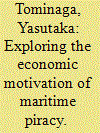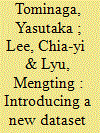| Srl | Item |
| 1 |
ID:
160211


|
|
|
|
|
| Summary/Abstract |
This paper presents two hypotheses regarding the relationship between marine fisheries and maritime piracy. These hypotheses are based on the opportunity and willingness framework and describe how fish values and production can drive fishermen to engage in illegal activities, and the mechanisms that their capabilities and choices make available to them stipulate the forms that piracy takes when facing a declining fishing economy. The hypotheses are tested with the Maritime Piracy Data (MPD) using the negative binomial regression and the bivariate Poisson model. This study uses the instrumental variable approach to deal with endogeneity through two instruments: chlorophyll concentrations and temperature. The statistical analysis shows that unsophisticated piracy attacks are sensitive to fish production, but sophisticated attacks can be affected by both fish production and fish values and depend on the opportunity cost of existing fisheries and finding work in other industries.
|
|
|
|
|
|
|
|
|
|
|
|
|
|
|
|
| 2 |
ID:
187558


|
|
|
|
|
| Summary/Abstract |
This article introduces a new dataset, Designated Terrorist Organizations (DTO), which details every terrorist organization designated or sanctioned by two IGOs and 148 state governments, as well as the timing of each designation. The DTO includes 281 terrorist groups that have been officially designated by at least one IGO or state government as well as 223 other active terrorist groups that have never been designated. The DTO has a dyadic structure that offers information on both the designating country and the designated group, such as the base location and past activities. We present some trends and patterns of terrorist designation over time and across countries and apply the DTO to analyze the impact of terrorist designation on groups’ attacks. Our preliminary findings show that terrorist designation is negatively associated with terrorist attacks, although the effect only appears in an earlier period.
|
|
|
|
|
|
|
|
|
|
|
|
|
|
|
|
| 3 |
ID:
158685


|
|
|
|
|
| Summary/Abstract |
This note analyzes the effectiveness of leadership targeting in deterring militant operations. It broadens how we think about their deterrence effects by including nontargeted groups. I argue that leadership decapitation of one group signals to other would-be aggressors a state's capability and determination to deploy such actions against them. Nontargeted groups are thus forced to recalculate the cost-benefit balance of conducting further attacks, which leads to indirect deterrence. Using the Global Terrorism Database from 1970 to 2008 and Price's (2012) leadership decapitation data, targeted capturing is found to deter operations by nontargeted groups, and this effect is magnified when those militants form an alliance. While targeted killing is frequently executed through drone strikes, incurring lower costs and risk for the state, the findings indicate that killing a leader does not reduce militant operations. Policymakers should recognize the unintended effect deriving from one leadership decapitation and transform it into an intended outcome to maximize their expected payoffs.
|
|
|
|
|
|
|
|
|
|
|
|
|
|
|
|